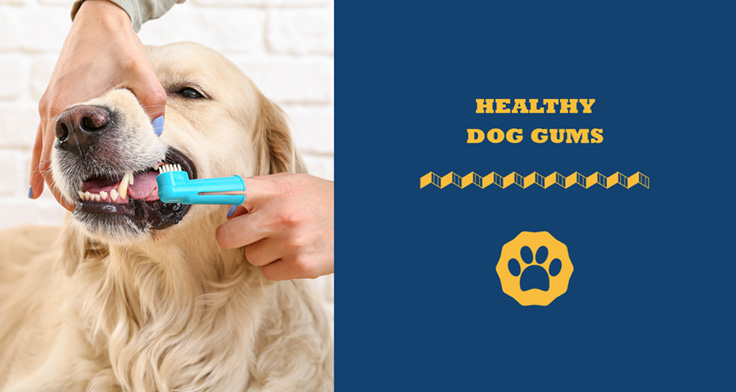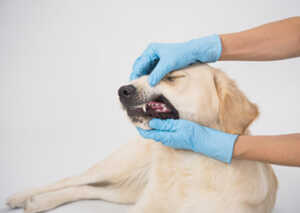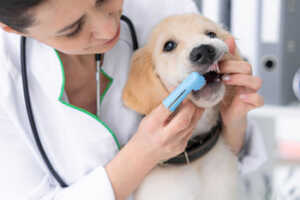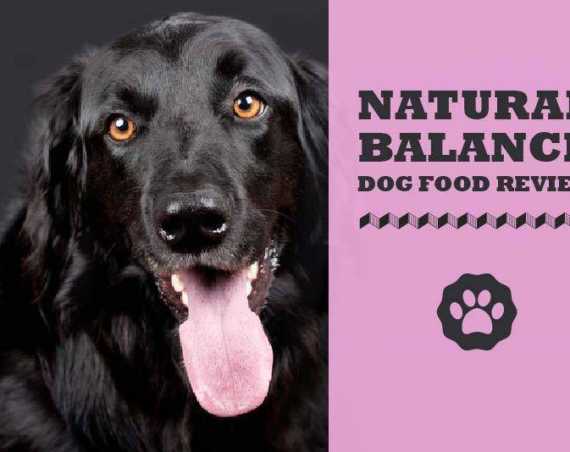Updated: November 11th, 2022
This article contains affiliate links. Read the full disclosure here.

What do healthy dog gums look like, and how do you maintain your pet’s oral health? Many pet owners worry about their dogs’ health after they notice signs of gum disease such as bleeding or swelling.
Gum disease is caused by bacteria that build up under the gum line, which increases inflammation. This leads to bad breath, tooth decay, loose teeth, and infection. If left untreated, canine gum disease can spread throughout the mouth and into other parts of the body.
However, gum disease is treatable–but only if caught and treated early. Regular dental checkups are important to prevent further damage. Your vet can also recommend home remedies to reduce plaque build-up and promote healing. In this post, I’ll provide information on signs of unhealthy gums and how to protect your dog’s oral health.
What Should Normal, Healthy Dog Gums Look Like?
Healthy dog gums should be salmon pink or bubblegum pink. However, this will depend on the dog’s breed because not all canines have the same color gums. Some dog breeds, such as chows, have purple gums, and other dogs’ gums may have black spots.
If your dog is a breed that should have pink gums, you can test your pet’s oral health by pressing lightly on their gums with your finger. The gums should ideally lighten to a pale white color when you remove your finger and then return to the normal pink after a second or two.
The amount of time it takes for the gums to return to the natural pink color is called the capillary refill time (CFT). This is a simple test to measure the time taken for color to return to the gums after pressure is applied. The longer it takes for color to come back, the more likely your dog has an underlying health issue.
Lastly, healthy dog gums should also be smooth, slippery, and wet. Take your dog to the vet for a check-up if the gums are dry and rough.
Common Gum Problems In Dogs
There are several canine gum problems you need to look out for. Some gum problems are caused by bacteria, fungi, or viruses.
Most often, the culprit is plaque build-up. This sticky substance forms on teeth and gums, and over time, it hardens and turns into tartar. Tartar build-up can irritate the gums and cause them to become inflamed. Here are other common canine gum problems to be aware of.
Pale Pink Gums In Dogs

If your dog has pale pink gums, there could be a lack of blood flow or hemoglobin in your dog. Hemoglobin is a red protein that transports oxygen in the blood of vertebrates. Pale pink gums are a sign of anemia or extreme blood loss. It can also cause pale gums in dogs.
Conditions that cause canine anemia can be serious and indicative of further underlying health issues such as cancer or an ulcer. To rule out any possible health issues based on the color of your dog’s gums, it’s best to take your pet to the vet for a check-up.
Red, Inflamed Gums In Dogs
Dogs that have bright red gums could be suffering from one of the following:
- Gingivitis
- Overheating
- Stomatitis
Signs your dog is struggling to regulate body temperature include excessive panting and red gums. You can help regulate your pet’s temperature by wetting your dog’s fur with cold water or giving them a cooler place to sit.
Furthermore, red gums is a common sign of inflammation, which can cause sensitivity and bleeding. This could be due to lack of oral hygiene or an underlying health condition such as diabetes.
Blue Gums In Dogs
Dogs that have blue gums may have a lack of oxygen flow in the bloodstream. Blue or purple gums are usually indicative of cyanosis, which is caused by issues such as:
- Pulmonary
- Pneumonia
- Thromboembolism
- Congestive heart failure
Treatment is dependent on the underlying cause of the oxygen deficiency. Ask your vet for assistance to treat the lack of oxygen in your dog’s bloodstream. You may need to provide your dog with doses of oxygen.
Black Gums In Dogs
As mentioned before, there are some dog breeds that naturally have black gums. But if your dog’s gums have always been bright pink and suddenly turn black, then your dog has a health issue.
Black gums in dogs may be caused by a vitamin B12 deficiency. The symptoms include lethargy, depression, vomiting, diarrhea, and even seizures. On the other hand, black gums can also be a sign of poor oxygenation.
Tumors
Another common gum problem dogs experience is growths and tumors. Sometimes, these growths are benign and don’t pose any health risks. Other times, they can be cancerous and cause sensitivity and pain.
Furthermore, there are growths caused by Papillomatosis that are contagious. If you find growths on your dog’s gums, it’s best to take your pet to the vet to get a diagnosis.
Gum Issues To Watch For In Goldens
Golden retriever dogs are prone to gum problems because they have large mouths and big teeth. The most common problem with this breed is periodontal disease. This type of disease causes severe tissue damage of the gums, and it affects ligaments and bones. Your golden may contract periodontal diseases after many years of tartar build-up and untreated gingivitis.
Upper back teeth are affected more by periodontal disease compared to the bottom set. Goldens can experience periodontal diseases after 2 years of age and if left untreated can cause tooth loss and gum sensitivity.
You can prevent gum diseases from developing by feeding your golden food for dental health. The hard pellets naturally clean your dog’s teeth by removing plaque from them.
How Can You Treat Canine Gum Problems?

Treatment for canine gum disease will depend on the type of problem you’re dealing with. For example, dogs that have gum diseases caused by respiratory problems need oxygen treatments.
On the other hand, dogs that have growth on the gums will need surgery to remove them and medication for pain and inflammation. If your dog has pale gums, you may need to administer medication for anemia.
Your dog will also need special treatment for bleeding gums, surgery, and tooth extractions to prevent swelling and relieve pain. You can catch canine gum problems early if you take your dog for regular check-ups at the vet.
Tips To Prevent Canine Gum Diseases
As you can see, gum disease is common among dogs and is a result of serious underlying health conditions. However, there are ways you can prevent canine gum diseases from developing. Here are tips that will help you maintain your dog’s oral health.
Brush Your Dog’s Teeth
To prevent tartar build-up, you should brush your dog’s teeth regularly with a pet-friendly toothbrush and toothpaste. There are a wide range of dog toothbrush kits that come with the correct size brushes and bristle stiffness to clean your dog’s teeth.
However, you don’t have to brush your dog’s teeth as often as you do your own pearly whites. This is because dogs should eat dry kibble pellets, which naturally clean their teeth. It’s recommended to brush your dog’s teeth three times a week. You can get them used to brushing by starting the process when they’re puppies.
Provide Your Dog With A Healthy Diet
Dogs can develop gum diseases due to a poor diet. Wet food doesn’t clean your dog’s teeth naturally like pellets do, so you should only feed your dog wet food in moderation. Additionally, some dog foods don’t have all the nutrients required for a healthy diet. Lack of vitamins and minerals can cause gum diseases in dogs.
You should consider feeding your dog foods that are rich in vitamins and minerals to promote a healthy gut, immune system, and gums. The best foods for gum health are Hill’s Prescription Diet Dental Care Dry Dog Food or Pedigree Pellets.
Clean Chewing Toys
Chew toys are fun for your dog to play with and can prevent your pet from gnawing on your shoes and furniture. However, chew toys harbor bacteria and germs that can cause canine gum diseases.
To prevent serious canine oral health conditions, you should clean your dog’s chew toys or replace them regularly.
Check For Signs Of Infection
Check your dog’s gums regularly for signs of infection. If you notice redness, swelling, or bleeding, contact your vet immediately. You can do the capillary refill time test on your dog’s gums or simply inspect them for any unnatural color changes. You can prevent gum diseases worsening if you check for signs of infection regularly.
Avoid Sugar Intake
Sugar feeds bacteria that causes gum disease. Limit your dog’s sugar intake by avoiding treats made with honey, molasses, corn syrup, or cane juice. You can administer healthier treats that contain oils with omegas instead. Alternatively, you can administer CBD treats, which can help with other types of problems such as:
- Canine anxiety
- Gut problems
- Muscle pain
- Joint stiffness
The best CBD treats to administer to your dog are PetHonesty Hemp Calming Chews and Zesty Paws Calming Soft Chews.
Don’t Overfeed Your Dog
Overfeeding your dog can lead to obesity, which increases your dog’s risk of heart disease and diabetes. These diseases can also affect your dog’s oral health. If your dog constantly eats, there will be less time for the saliva in the mouth to wash out food stuck in the gum lining and in between teeth.
You should develop a consistent routine for your dog so they know when it’s time to eat. Furthermore, the amount of food given must be specific to your dog’s size. You can prevent health conditions that cause gum inflammation and bleeding if you feed your dog correctly.
Provide Plenty Of Water And Exercises
Exercise stimulates saliva production, which flushes out toxins and reduces plaque buildup. You should take your dog out for walks every day or play fetch with your dog to boost saliva production in the mouth.
Additionally, you should provide your dog with plenty of water, which also helps to flush out the system and wash food out of your dog’s teeth. Your dog’s water bowl should be full at all times.
What Does Your Golden’s Gum Color Mean?
Your Golden retriever’s gum color should be bright pink, which indicates that your dog has excellent oral health. But if your golden’s gums start changing, it could be the onset of gum disease or health issues.
Similar to other dog breeds, the color of your golden’s gums can change to:
- Yellow: Older dog breeds can have yellowish gums, which can be a sign of jaundice (icterus).
- Black/blue: Low oxygen flow in the bloodstream.
- Pale pink or white: Can be a sign of anemia or blood loss.
- Brown: Could be caused by methemoglobinemia, which is a blood disorder.
- Raised black spots: This could indicate the onset of a growth. These growths can be harmless, but it’s best to get a diagnosis from your vet.
What Are The Signs Of Unhealthy Canine Gums?
To prevent gum diseases from developing in your dog’s mouth, it’s important for you to know the first signs of canine gum diseases. We’ve discussed the first sign, which is the change of gum color. Here are other signs to be aware of:
- Sensitive gums: If your dog whimpers while chewing pellets, it can be a sign of sensitive gums or the onset of gingivitis.
- Bleeding gums: Chewing on hard objects can cause gums to bleed. But if you notice that your dog’s gums are bleeding for no reason, it could be signs of periodontal disease.
- Loose teeth: Your adult dog’s teeth should not be loose. This is a symptom of gingivitis and periodontal disease in dogs.
- Irritability: Dogs are playful and shouldn’t exhibit anger or irritability. If you notice your dog snaps or growls when you try to touch his or her mouth, your pet could be suffering from gum sensitivity or pain.
- Excessive drooling: If your dog is drooling, he or she could be suffering from toothache or gum sensitivity.
- Lack of appetite: Your dog may not want to eat because it hurts to chew food. Wet food may not be the best idea if your dog has open sores in the mouth.
If you notice any of the above symptoms, it’s best to contact your vet for a check-up. You can then get a proper diagnosis along with the medication needed to assist your dog.
FAQs About Healthy Dog Gums And Teeth
What causes dog gingivitis?
Similar to humans, dog gingivitis is caused by plaque build-up. The risk of gingivitis increases if you don’t brush your dog’s teeth regularly. You can also keep your dog’s teeth clean by feeding your dog pellets to naturally remove plaque from the gum line.
How often should I brush my dog’s teeth?
Dogs don’t need to have their teeth brushed every day, especially if they eat pellets or chew on bones. But it’s recommended to brush your dog’s teeth at least three times a week to prevent plaque build-up. You can keep your dog’s gums healthy if you use the right toothbrush and toothpaste.
Should I give my dog dental treats?
Yes, you should give dogs dental treats because it helps keep their teeth clean and their gums healthy. Some dental treats also have vitamins and minerals that promote healthy gums and prevent diseases from developing.
Does brushing your dog’s teeth hurt their gums?
No, brushing your dog’s teeth shouldn’t hurt their gums if you use the right toothbrush. You should also avoid applying too much pressure when brushing your dog’s teeth because it can tear the gums. You will know if your dog has sensitive gums if he or she whimpers or yelps during brushing.
Additionally, if your dog’s gums start bleeding while you’re brushing, you should stop immediately and book your dog for a vet visit.
Can underlying health conditions cause canine health problems?
Yes, there are some illnesses such as cancer, anemia, and diabetes that can cause canine gum diseases. This requires you to take extra care of your dog’s oral health. Make sure they have plenty of water and you provide them with dental chews to help clean their teeth naturally.
Wrap Up – Additional Canine Oral Health Tips
Taking care of your dog’s oral health will prevent diseases from developing. It’s important to check your dog’s gums regularly to ensure they are always in healthy condition. To prevent plaque build-up that causes canine gum diseases, allow your dog to chew on bones that won’t splint.
Additionally, you can add dental powder to your dog’s food which kills bacteria and has the minerals to promote excellent gum health. You can also use the tips in this article to help prevent your dog from developing gum diseases.
Finally, keep an eye out for the following symptoms when cleaning and checking your dog’s teeth, as these can be indicative of underlying health issues:
- Excess bleeding from the gums
- Discoloration of the gums (which should normally be pink)
- Loose or damaged teeth
- Irritability or yelping when eating or having their teeth brushed
If you have any comments or first hand experiences with healthy dog gums and how to maintain them, please post them below or share your pictures via our social media.



